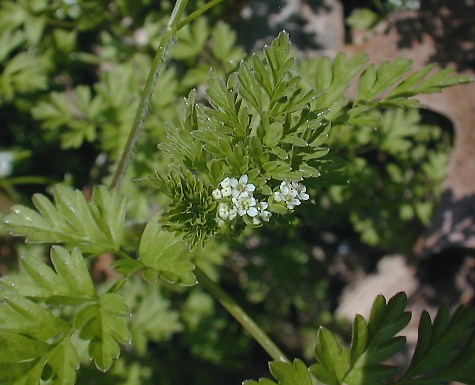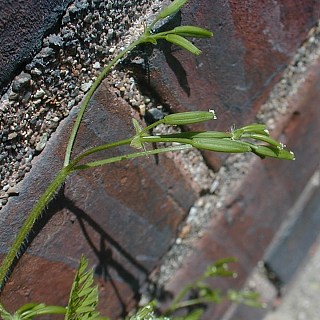Description: This plant is a winter or spring annual about ½–1½' tall. Several branching stems develop from the base of the plant; they often sprawl across the ground or lean on adjacent vegetation for support. The stems are light green to purplish green, more or less hairy, and shiny; the hairs occur in lines along the stems or in tufts where the stems branch. The blades of the alternate leaves are up to 4" long and 2" across; they are medium green, hairless to mostly hairless, double-pinnate, and triangular-lanceolate in shape. The pinnatifid leaflets are shallowly to deeply cleft and their tips are obtuse. The petioles of the lower leaves are about as long as the blades, while the upper leaves have short petioles or they are nearly sessile. A membranous sheath wraps around the base of each petiole.

The upper stems
terminate in compound umbels of small white flowers. The typical
compound umbel has about 3 umbellets, and each umbellet has 3-7
flowers; the divergent stalks of the umbels and umbellets are green and
glabrous. The flowers often bloom before the compound umbels have fully
expanded. Each flower is less than 1/8" across; it has 5 white petals,
5 stamens, a divided style, insignificant sepals, and a cylindrical
green ovary. The blooming period occurs from mid-spring to early
summer. Upon reaching maturity, each flower is replaced by a
single-seeded fruit. The fruits are about ¼" long, narrowly
oblongoid-ellipsoid, and broadest toward the middle; usually the fruits
are glabrous, although less often they are finely pubescent. Each fruit
has a few longitudinal ridges that are broad and flat; these ridges are
separated by narrow grooves. The root system consists of a taproot.
This plant spreads by reseeding itself.
Cultivation:
The preference is partial sun, moist conditions, and a fertile loamy
soil. This species is somewhat weedy.
Range & Habitat:
The native Wild Chervil is common in most areas of Illinois (see Distribution
Map). Typical habitats include lowland woodlands, open
woodlands, woodland
borders, thickets, rocky glades, areas adjacent to buildings, and areas
along roads and railroads. Habitats with a history of disturbance and
some shade are
preferred.
Faunal Associations:
The flowers are occasionally visited by small bees (especially Halictid
bees), parasitic wasps, flies (especially Syrphid flies), and beetles.
These insects usually suck nectar from the flowers, although some bees
also collect pollen. The caterpillars of the butterfly Papilio
polyxenes asterias (Black Swallowtail) feed on the foliage.
Photographic Location:
Along a building on the campus of the University of Illinois in Urbana,
Illinois. The photographed plant is the typical variety, Chaerophyllum
procumbens procumbens.
Comments:
The foliage of this native wildflower is similar to cultivated species
of parsley and chervil. Cultivated Parsley is a biennial that doesn't
naturalize in Illinois because its rosettes are unable to survive the
cold weather of winter. However, Anthriscus cerefolium
(Cultivated Chervil) and Anthriscus sylvestris (Bur
Chervil) occasionally naturalize in Illinois (especially the latter
species). Unlike Wild Chervil, both Cultivated and Bur Chervil lack
bractlets underneath their umbellets. The species Chaerophyllum
tainturieri (Southern Wild Chervil), which occurs in
southern Illinois, is even more similar to Wild Chervil than the
preceding species. The single-seeded fruits of Southern Wild Chervil
are broadest below the middle and the pedicels of its flowers/fruits
have a wider diameter toward the top than the bottom. In contrast, the
single-seeded fruits of Wild Chervil are broadest toward the middle and
the pedicels of its flowers/fruits have the same diameter throughout.
Two varieties of Wild Chervil have been described: the typical variety,
Chaerophyllum procumbens procumbens, has glabrous
fruits, while Chaerophyllum procumbens shortii has
fruits that are finely pubescent. This latter variety is less common in
Illinois than the typical variety.